- Home
- Middle East
- Operations in Ukraine Remain Unabated Despite Winter

©(Genya SAVILOV, AFP)
While the world’s attention remains focused on the raging conflict between Israel and Hamas and its allies in the Iranian axis, another conflict continues to cause widespread devastation. Despite the shift in media attention, Ukraine and Russia persistently strive to achieve their objectives on all fronts, employing every possible means.
As winter tightens its grip on the Ukrainian front, combatants on both sides contend with harsh weather conditions—freezing temperatures and a growing blanket of snow. The war, stemming from Russia's invasion of Ukraine in February 2022, is approaching its third year, while the overall situation appears to be at a standstill.
Nevertheless, this does not indicate a decrease in either combat or diplomatic efforts. In this context, here are the key developments related to the Russian invasion of Ukraine.
After the failure of Kiev's counteroffensive in the Zaporijjia region, the Russian army regained the initiative on multiple fronts during the fall. This is notably the case in Avdiivka, an industrial city in the Ukrainian Donbass region, which Moscow and its separatist allies have been striving to conquer since 2014.
This small town, built around a vast coal factory, has become the new focal point of the conflict. Hence, its proximity to Donetsk, the capital of the eponymous region under Russian control, located just 13 kilometers away, poses a continuous threat to the latter.
 Ukrainian tank crew near the front line in the Donetsk region on November 21, 2023. (Anatolii Stepanov, AFP)
Ukrainian tank crew near the front line in the Donetsk region on November 21, 2023. (Anatolii Stepanov, AFP)
Therefore, Ukrainian forces have been hiding behind strong fortifications in the area since 2014. This is also the reason the Russian army is deploying substantial resources, now using the tactic of sending troops in “human waves” to attempt to encircle the city, as outlined by the American “think tank”, the Institute for the Study of War (ISW).
This allows the Kremlin to make modest local gains. The Telegram channel Rybar, closely associated with the Russian army and widely followed, declared that Russian forces seized an “industrial zone southwest of Avdiivka” on Saturday evening. It also reported “intense combats” on the northern side of the city, near the coal factory transformed by Kiev into a real fortress.
This has also resulted in devastating consequences, characterized by massive losses, akin to the situation in Bakhmut, as reported by Ukrainian defenders. But this is not stopping the Kremlin from further increasing the size of its armed forces: on Monday December 1, Russian President Vladimir Putin announced a 15% increase in the number of troops.
While Russia escalates its hostility toward Avdiivka, Ukraine is attempting to consolidate a bridgehead on the left bank of the Dnieper, currently occupied by the Russian military and facing Kherson. However, military experts interviewed by AFP believe that converting it into a significant breakthrough will pose considerable challenges.
In late October, Moscow replaced the commander of the Russian military group “Dnieper” operating in the area. Analysts attribute this change to the challenging situation.
According to French military expert Michel Goya, the Ukrainian operation is “relatively limited and symbolic,” yet it “allows the proclamation of small victories following the failure of the main offensive.”
 Ukrainian soldier guards an area of the Dnipro river in an undisclosed location in the Kherson region on November 6, 2023. (Roman PILIPEY, AFP)
Ukrainian soldier guards an area of the Dnipro river in an undisclosed location in the Kherson region on November 6, 2023. (Roman PILIPEY, AFP)
To turn its success into a major breakthrough, the Ukrainian army must deploy its forces on the opposite side of the river.
Securing positions in depth could potentially allow Kiev to launch a more important assault towards the Crimea Peninsula, annexed by Russia in 2014. However, experts estimate that achieving this would require deploying thousands of troops and heavy vehicles.
For this task, “bridges over the Dnieper are necessary, as every pontoon bridge would be vulnerable to Russia's air and ground firepower, which has not been completely eliminated,” notably to drones, says Mykola Bielieskov, a Ukrainian military analyst.
While combat continues to rage on the front lines, both camps persist in undertaking deep strike campaigns, particularly through kamikaze drones.
On the night of Friday, November 24, to Saturday, November 25, Kiev was targeted by the largest Russian drone attack since the start of the invasion in February 2022.
Using 75 Iranian-made “Shahed” drones, Moscow has notably succeeded in damaging a part of the capital's electrical grid. Far from staying inactive, the Ukrainian air defense reportedly intercepted and shot down 71 such aircraft.
Ukraine swiftly retaliated by launching 24 drones, targeting objectives in four Russian regions, including Moscow. Russian air defense, however, asserted that it had successfully intercepted and shot down some of them.
 Ukrainian serviceman stand behind a machine gun as a drone flies during an anti-drone exercise in the Chernihiv region on November 11, 2023. (Sergei SUPINSKY, AFP)
Ukrainian serviceman stand behind a machine gun as a drone flies during an anti-drone exercise in the Chernihiv region on November 11, 2023. (Sergei SUPINSKY, AFP)
Compared to other means of delivering explosive payloads, suicide drones can be a relatively more cost-effective option in terms of production and deployment. This renders them enticing to both parties. Notably, with certain models capable of reaching targets far beyond enemy lines, drones have become the new battle horse for both camps.
Operating at a slow pace and generally maintaining low altitudes, they may become particularly difficult to detect, especially when the adversary has to defend extensive areas, as is notably the case for Ukraine and more specifically for Russia.
Consequently, Russia is compelled to spend more money to guarantee the protection of its territories. Inevitably, the defender invests greater resources than those invested by the attacker in the fabrication of drones.
Since October, Ukraine has witnessed a significant decline in its bomb supplies due to the raging Israel-Hamas war. Ukrainian President Volodymyr Zelensky voiced his concern on Thursday, November 23, noting that globally, “warehouses are now either empty or contain only the minimum required, a situation that certain states are unable to address.”
Confronting this danger, Western countries, staunch supporters of the Ukrainian military effort since the early days of the Russian invasion, are increasingly issuing reassuring statements. Yet, in reality, a Ukrainian official revealed to ABC News that the delivery of American bomb ammunition to Ukraine has decreased by 30% since the outbreak of the war in Gaza.
 Ukrainian President Volodymyr Zelensky and Colonel General Oleksandr Syrskyi visit the Ukrainian army command post at Kupiansk, in Kharkiv region, on November 30, 2023. (AFP)
Ukrainian President Volodymyr Zelensky and Colonel General Oleksandr Syrskyi visit the Ukrainian army command post at Kupiansk, in Kharkiv region, on November 30, 2023. (AFP)
This issue is especially serious given that, on the opposite side of the front line, Russian forces are accumulating missiles ahead of massive attacks on Ukrainian infrastructure this winter, according to the Ukrainian president.
In addition, the worrisome aspect extends to the abundance of munitions supplied by North Korea, intensifying its partnership with Moscow, a matter of profound concern for Washington. However, there is a meager compensation: The munitions transferred by Pyongyang constitute a stock of bad quality, characterized by a significant default rate.
[readmore url="https://thisisbeirut.com.lb/world/204602"]
During a virtual G20 meeting, Russian President Vladimir Putin stated that Moscow is “prepared to engage in discussions” to bring an end to the “tragedy” of the war, simultaneously accusing Kiev of avoiding the question. In response, German Chancellor Olaf Scholz urged the Russian leader to withdraw his troops from Ukraine.
The timing chosen by the Russian leader to make his statement comes as no surprise. He certainly aims to capitalize on the decreasing American assistance, shared between Israel and Kiev, while attempting to sow further divisions in Western opinions. Currently, time appears to favor Putin: the rise of the far-right in the West, combined with the multitude of electoral deadlines scheduled for 2024—notably in the US—could play into Moscow's interest.
 Ukrainian Foreign Minister Dmytro Kuleba (L) and NATO Secretary General Jens Stoltenberg (R) at NATO headquarters in Brussels on November 29, 2023. ( Simon WOHLFAHRT, AFP)
Ukrainian Foreign Minister Dmytro Kuleba (L) and NATO Secretary General Jens Stoltenberg (R) at NATO headquarters in Brussels on November 29, 2023. ( Simon WOHLFAHRT, AFP)
Initiating negotiations at this point could serve to safeguard Putin's territorial gains. It would, notably, help him save face following the failure of his initial operation. What Ukrainian and Western observers particularly fear is that this could offer him a welcome reprieve to rebuild his forces, with the looming risk of launching a new offensive in the years to come.
Asked about the risk of Kiev being compelled to engage in negotiations with Moscow in the event of a reduction in Western military support, NATO Secretary-General Jens Stoltenberg reiterated that it was Ukraine's decision “to determine what is acceptable to end the war.” He made this statement during a meeting of the Alliance on Tuesday, November 28.
However, this statement contrasts with a more recent one: in an interview with the ARD television channel, Stoltenberg said that “we should be prepared for bad news" regarding Ukraine. Support for Ukraine is also provoking discontent within the European Union, as illustrated by Hungarian Prime Minister Viktor Orban and his Slovakian counterpart Robert Fico.
[readmore url="https://thisisbeirut.com.lb/world/204897"]
As winter tightens its grip on the Ukrainian front, combatants on both sides contend with harsh weather conditions—freezing temperatures and a growing blanket of snow. The war, stemming from Russia's invasion of Ukraine in February 2022, is approaching its third year, while the overall situation appears to be at a standstill.
Nevertheless, this does not indicate a decrease in either combat or diplomatic efforts. In this context, here are the key developments related to the Russian invasion of Ukraine.
Will Avdiivka Be the New Bakhmut?
After the failure of Kiev's counteroffensive in the Zaporijjia region, the Russian army regained the initiative on multiple fronts during the fall. This is notably the case in Avdiivka, an industrial city in the Ukrainian Donbass region, which Moscow and its separatist allies have been striving to conquer since 2014.
This small town, built around a vast coal factory, has become the new focal point of the conflict. Hence, its proximity to Donetsk, the capital of the eponymous region under Russian control, located just 13 kilometers away, poses a continuous threat to the latter.
 Ukrainian tank crew near the front line in the Donetsk region on November 21, 2023. (Anatolii Stepanov, AFP)
Ukrainian tank crew near the front line in the Donetsk region on November 21, 2023. (Anatolii Stepanov, AFP)Therefore, Ukrainian forces have been hiding behind strong fortifications in the area since 2014. This is also the reason the Russian army is deploying substantial resources, now using the tactic of sending troops in “human waves” to attempt to encircle the city, as outlined by the American “think tank”, the Institute for the Study of War (ISW).
This allows the Kremlin to make modest local gains. The Telegram channel Rybar, closely associated with the Russian army and widely followed, declared that Russian forces seized an “industrial zone southwest of Avdiivka” on Saturday evening. It also reported “intense combats” on the northern side of the city, near the coal factory transformed by Kiev into a real fortress.
This has also resulted in devastating consequences, characterized by massive losses, akin to the situation in Bakhmut, as reported by Ukrainian defenders. But this is not stopping the Kremlin from further increasing the size of its armed forces: on Monday December 1, Russian President Vladimir Putin announced a 15% increase in the number of troops.
Ukrainian Stronghold on the Southern Bank of the Dnieper
While Russia escalates its hostility toward Avdiivka, Ukraine is attempting to consolidate a bridgehead on the left bank of the Dnieper, currently occupied by the Russian military and facing Kherson. However, military experts interviewed by AFP believe that converting it into a significant breakthrough will pose considerable challenges.
In late October, Moscow replaced the commander of the Russian military group “Dnieper” operating in the area. Analysts attribute this change to the challenging situation.
According to French military expert Michel Goya, the Ukrainian operation is “relatively limited and symbolic,” yet it “allows the proclamation of small victories following the failure of the main offensive.”
 Ukrainian soldier guards an area of the Dnipro river in an undisclosed location in the Kherson region on November 6, 2023. (Roman PILIPEY, AFP)
Ukrainian soldier guards an area of the Dnipro river in an undisclosed location in the Kherson region on November 6, 2023. (Roman PILIPEY, AFP)To turn its success into a major breakthrough, the Ukrainian army must deploy its forces on the opposite side of the river.
Securing positions in depth could potentially allow Kiev to launch a more important assault towards the Crimea Peninsula, annexed by Russia in 2014. However, experts estimate that achieving this would require deploying thousands of troops and heavy vehicles.
For this task, “bridges over the Dnieper are necessary, as every pontoon bridge would be vulnerable to Russia's air and ground firepower, which has not been completely eliminated,” notably to drones, says Mykola Bielieskov, a Ukrainian military analyst.
Drone War
While combat continues to rage on the front lines, both camps persist in undertaking deep strike campaigns, particularly through kamikaze drones.
On the night of Friday, November 24, to Saturday, November 25, Kiev was targeted by the largest Russian drone attack since the start of the invasion in February 2022.
Using 75 Iranian-made “Shahed” drones, Moscow has notably succeeded in damaging a part of the capital's electrical grid. Far from staying inactive, the Ukrainian air defense reportedly intercepted and shot down 71 such aircraft.
Ukraine swiftly retaliated by launching 24 drones, targeting objectives in four Russian regions, including Moscow. Russian air defense, however, asserted that it had successfully intercepted and shot down some of them.
 Ukrainian serviceman stand behind a machine gun as a drone flies during an anti-drone exercise in the Chernihiv region on November 11, 2023. (Sergei SUPINSKY, AFP)
Ukrainian serviceman stand behind a machine gun as a drone flies during an anti-drone exercise in the Chernihiv region on November 11, 2023. (Sergei SUPINSKY, AFP)Compared to other means of delivering explosive payloads, suicide drones can be a relatively more cost-effective option in terms of production and deployment. This renders them enticing to both parties. Notably, with certain models capable of reaching targets far beyond enemy lines, drones have become the new battle horse for both camps.
Operating at a slow pace and generally maintaining low altitudes, they may become particularly difficult to detect, especially when the adversary has to defend extensive areas, as is notably the case for Ukraine and more specifically for Russia.
Consequently, Russia is compelled to spend more money to guarantee the protection of its territories. Inevitably, the defender invests greater resources than those invested by the attacker in the fabrication of drones.
Controversy Surrounding Ammunition Replenishment
Since October, Ukraine has witnessed a significant decline in its bomb supplies due to the raging Israel-Hamas war. Ukrainian President Volodymyr Zelensky voiced his concern on Thursday, November 23, noting that globally, “warehouses are now either empty or contain only the minimum required, a situation that certain states are unable to address.”
Confronting this danger, Western countries, staunch supporters of the Ukrainian military effort since the early days of the Russian invasion, are increasingly issuing reassuring statements. Yet, in reality, a Ukrainian official revealed to ABC News that the delivery of American bomb ammunition to Ukraine has decreased by 30% since the outbreak of the war in Gaza.
 Ukrainian President Volodymyr Zelensky and Colonel General Oleksandr Syrskyi visit the Ukrainian army command post at Kupiansk, in Kharkiv region, on November 30, 2023. (AFP)
Ukrainian President Volodymyr Zelensky and Colonel General Oleksandr Syrskyi visit the Ukrainian army command post at Kupiansk, in Kharkiv region, on November 30, 2023. (AFP)This issue is especially serious given that, on the opposite side of the front line, Russian forces are accumulating missiles ahead of massive attacks on Ukrainian infrastructure this winter, according to the Ukrainian president.
In addition, the worrisome aspect extends to the abundance of munitions supplied by North Korea, intensifying its partnership with Moscow, a matter of profound concern for Washington. However, there is a meager compensation: The munitions transferred by Pyongyang constitute a stock of bad quality, characterized by a significant default rate.
[readmore url="https://thisisbeirut.com.lb/world/204602"]
Stalemate in Negotiations
During a virtual G20 meeting, Russian President Vladimir Putin stated that Moscow is “prepared to engage in discussions” to bring an end to the “tragedy” of the war, simultaneously accusing Kiev of avoiding the question. In response, German Chancellor Olaf Scholz urged the Russian leader to withdraw his troops from Ukraine.
The timing chosen by the Russian leader to make his statement comes as no surprise. He certainly aims to capitalize on the decreasing American assistance, shared between Israel and Kiev, while attempting to sow further divisions in Western opinions. Currently, time appears to favor Putin: the rise of the far-right in the West, combined with the multitude of electoral deadlines scheduled for 2024—notably in the US—could play into Moscow's interest.
 Ukrainian Foreign Minister Dmytro Kuleba (L) and NATO Secretary General Jens Stoltenberg (R) at NATO headquarters in Brussels on November 29, 2023. ( Simon WOHLFAHRT, AFP)
Ukrainian Foreign Minister Dmytro Kuleba (L) and NATO Secretary General Jens Stoltenberg (R) at NATO headquarters in Brussels on November 29, 2023. ( Simon WOHLFAHRT, AFP)Initiating negotiations at this point could serve to safeguard Putin's territorial gains. It would, notably, help him save face following the failure of his initial operation. What Ukrainian and Western observers particularly fear is that this could offer him a welcome reprieve to rebuild his forces, with the looming risk of launching a new offensive in the years to come.
Asked about the risk of Kiev being compelled to engage in negotiations with Moscow in the event of a reduction in Western military support, NATO Secretary-General Jens Stoltenberg reiterated that it was Ukraine's decision “to determine what is acceptable to end the war.” He made this statement during a meeting of the Alliance on Tuesday, November 28.
However, this statement contrasts with a more recent one: in an interview with the ARD television channel, Stoltenberg said that “we should be prepared for bad news" regarding Ukraine. Support for Ukraine is also provoking discontent within the European Union, as illustrated by Hungarian Prime Minister Viktor Orban and his Slovakian counterpart Robert Fico.
[readmore url="https://thisisbeirut.com.lb/world/204897"]

Comments